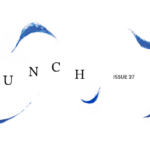Roya Zendebudie’s hybrid, experimental flash fiction piece “Eye, آی” incorporates multiple languages and genres in its exploration of communication, meaning, and experience. An excerpt of the story’s beginning is included below. Read the full piece in SAND 25.
Look at
the word چشم how
it resembles the eye
how it curves and tears, then slides
down, dead
⬤
Hold it in your hand, the word, and what it is, turn it around, چشم.
It’s not a word but the performance of a word, of what it wants to be but fails, a failure so intense it bursts the word wide open: the curve, barely begun, erupts and melts into points—light points, rain drops: three up, three down. It slides, it falls. It’s the vision of an eye, raw, open, slashed. Flooded into, rained on. Tromped and thrashed.
It’s dead, which almost means it’s alive.
⬤
Mein Gott, ich habe kein Dach über mir, und es regnet mir in die Augen.
⬤
Eye, I, Eye, I.
چشم holds two meanings in persian, eye and yes, I will obey.
The latter, unlike the english eye, is not an I but a negation of an I, an erasure of self for the sake of the other. The sound of eye for persian speakers is an interjection, used reflexively when the speaker is hurt; it’s a vocalized pain.
Aye, Aye, Captain.
⬤
Footnotes:
- آی is pronounced the same as eye or aye.
- چشم is pronounced chashm or ČAŠM.
- German text quoted from Rainer Maria Rilke’s Die Aufzeichnungen des Malte Laurids Brigge. Translation: “My God, I have no roof over me, and it is raining in my eyes.”
Roya Zendebudie is an MA student of English Studies: Literature, Language, Culture at Freie Universität Berlin. Her previous work has been published in Tint Journal.
KEEP ON READING
From Pantyhose for Daisy by Dewi de Nijs Bik tr. Emma Rault
Poetry | Issue 26: Shifting (translated
Eye, آی by Roya Zendebudie Read More »



